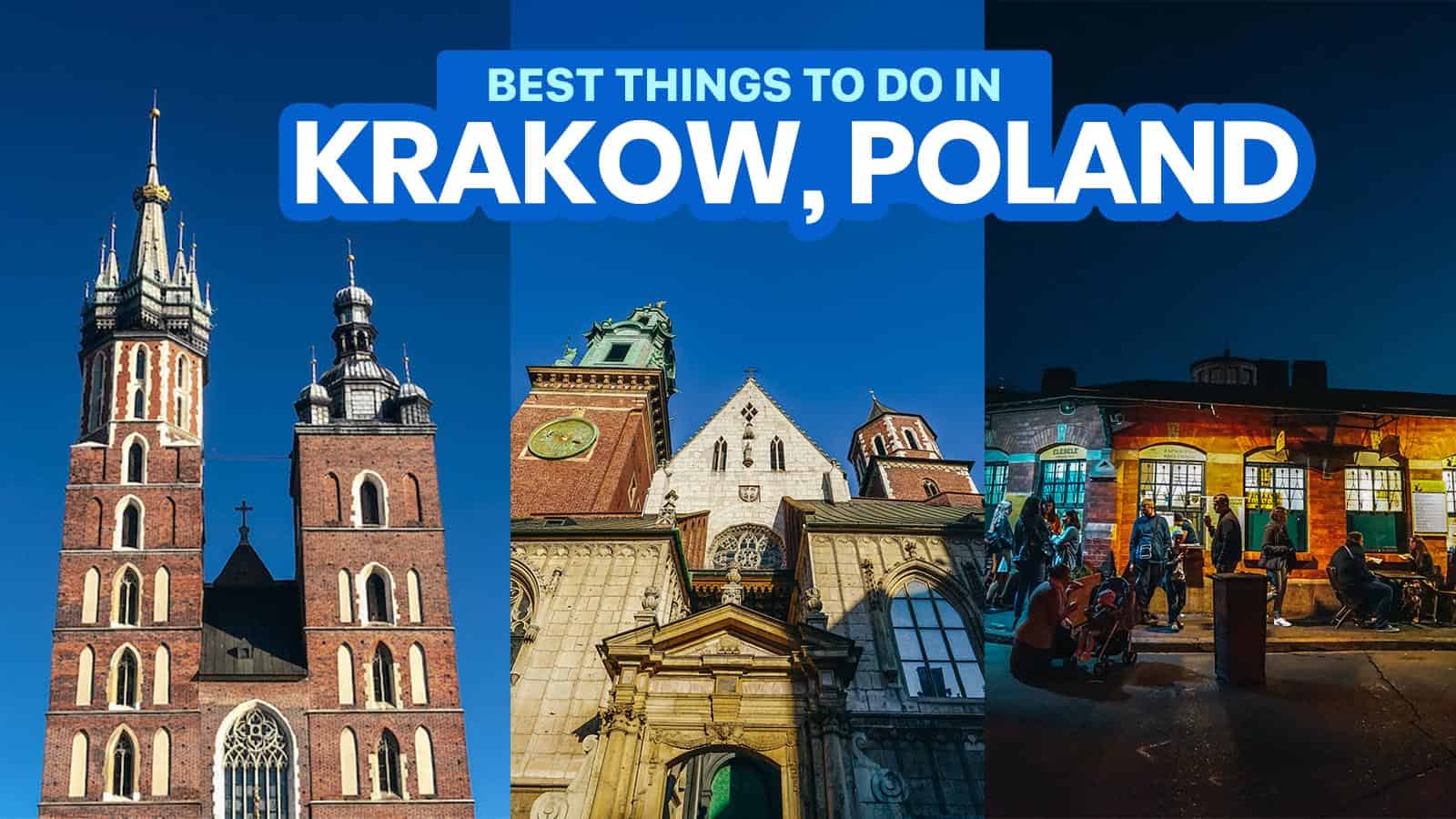Krakow is the second-largest city in Poland and is hailed as one of the most beautiful cities in Europe. It has been one of the country’s hubs for finance, arts, culture, and education. Cradling thousands of historical and cultural monuments, its historic center, Stare Miasto, is one of the first entries in UNESCO’s list of World Heritage Sites.
The city is very navigable, thanks to its very efficient public transportation system, made up of trams, buses, and trains. The Old Town Center is a pedestrian zone but tram stations surround the perimeter.
The Old Town center alone will fill your itinerary with notable sites and landmarks. If Krakow is part of your European trip itinerary, here are some of the things to do and places to visit. The first six in this list are tours, while the rest are specific spots or attractions. We’re including links for tours and tickets in case you want to book in advance.
Old Town Walking Tour
It is said that Krakow’s historic center, which encompasses the Old Town (Stare Miasto), the Kazimierz district, and the Wawel district (particularly the Wawel Castle), is among the first entries in the original UNESCO World Heritage Site list.
The Old Town is part of the first administrative district, considered the nucleus of the city’s formation that goes back to the 7th century. The medieval town was demarcated by a three-kilometer defensive wall with several towers and seven entrances. Today, most of the walls are destroyed, but the boundary that was once created by the wall and the moat surrounding it were now replaced by a belt of a green space, the Platy Park.
A walking tour within the Old Town district is a delightful treat for history-starved travelers as the area nestles about six thousand historical landmarks — from statues to buildings (religious and secular). The most visited sites are Rynek Główny, Wawel Castle, Wawel Cathedral, St. Mary’s Basilica, St. Florian’s Gate, and Krakow Barbican, among others.
The Royal Road is the most popular route because most of the famous landmarks are located along the road. It divides the Old Town district into east and west zones. You will also spot horse-drawn carriages and rickshaws.
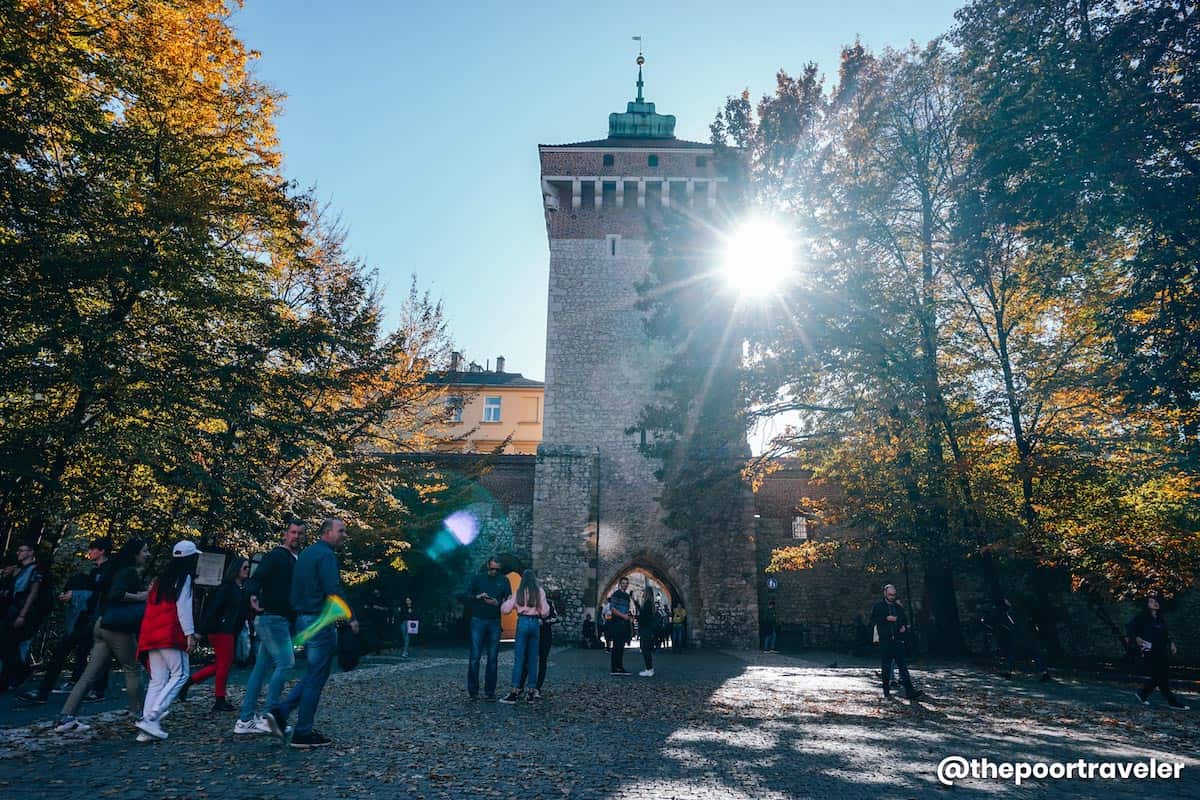
You can definitely do it on your own, but if you want more insights, you can join a guided tour. There are FREE Walking Tours around the Old Town that usually start at the area between the Barbican and St. Florian’s Gate. Although technically free, note that you’re expected to tip the guide at the end of the tour. How much is completely up to you. But because it’s free, these tours usually attract large crowds.
If you want to tour with a smaller group or you’d rather pay, book the guided walking tour! Just follow the link below for the details.
Podgorze & Jewish Quarter Tour
Since the 14th century, the Polish Jews coexisted with the ethnic Polish in Kazimierz, located southeast of the Old Town center on the left (northern) bank of Vistula River. The northeast portion of Kazimierz used to be the center of Jewish activities before World War II broke.
But in the early 1940s, the Jewish population in Krakow was relocated to Podgorze at the foot of the Lasota Hill on the other side of the Vistula River on its right (southern) bank. This is where the Jewish Quarter (sometimes called Jewish Ghetto) was established.
If you want to go deeper into the history of the Jewish people in Krakow, especially during WWII when the Nazi forces condemned them, you can find guided walking tours within the Jewish Quarter. There are tour packages that include Plaszow Concentration Camp and Oskar Schindler’s Factory in the itinerary.
Auschwitz Concentration Camp
Located over 70 kilometers west of Krakow is Auschwitz, notorious for the Nazi concentration and death camps during World War II and the Holocaust. The vast complex covered about 40 concentration camps, which originally detention centers for political and war prisoners of the Nazi but later became torture chambers and death camps.
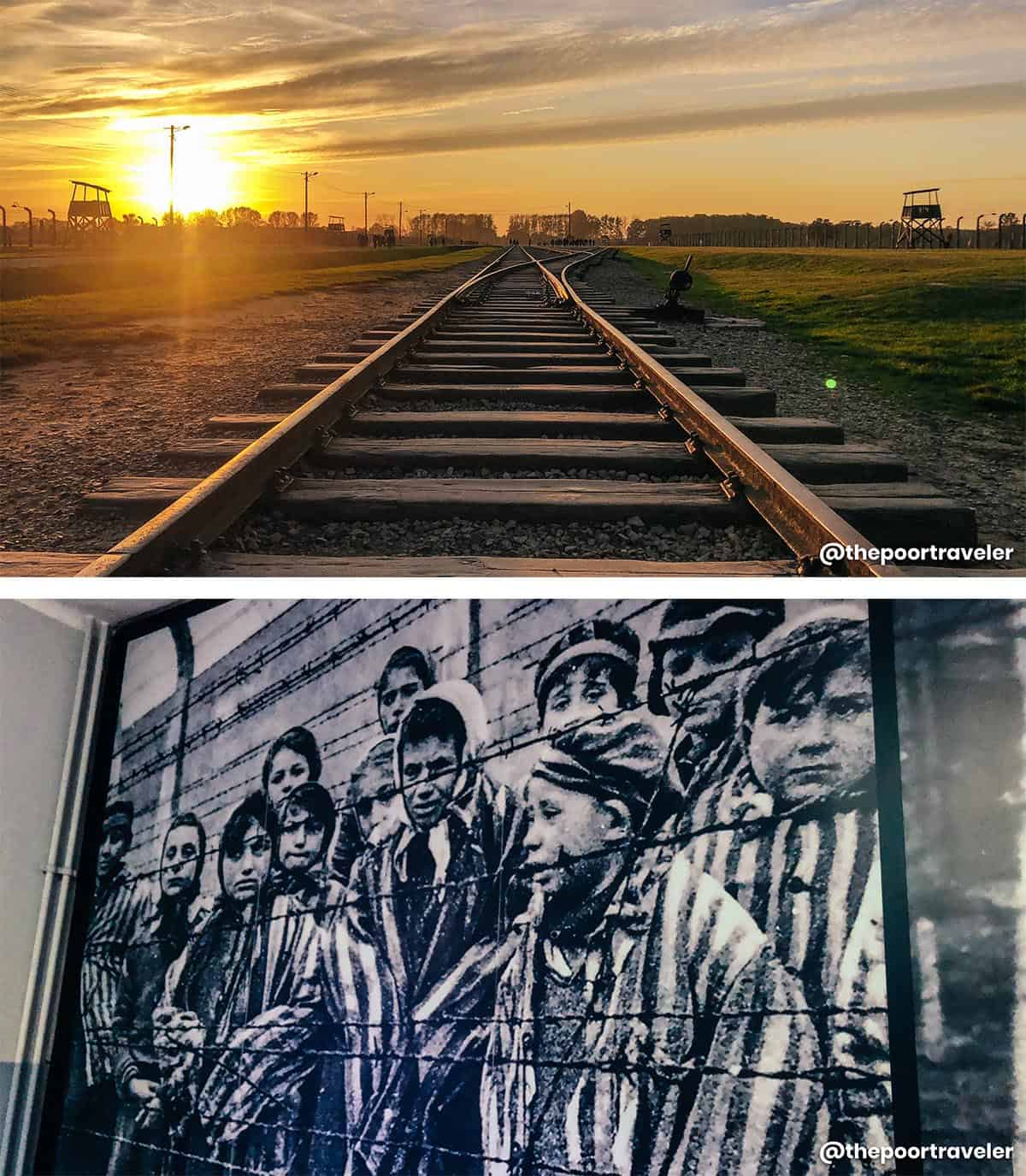
Today, the site has been converted into a memorial site and museum. This is a UNESCO World Heritage Site. A visit to the site can be really heavy and emotional.
Getting There: From Krakow, go to MDA Bus Station Krakow located behind Kraków Główny Station. Board a bus bound for Auschwitz/Oswiecim. The travel time is about two hours. From the bus stop, you can reach the museum in about 10 minutes on foot. If you will take the train, go to Kraków Główny (Main Train Station) and take the train to Oswiecim Station. The travel time is about an hour and a half. From there, you can either walk (30 minutes) or take a bus (10 minutes) to the museum.
Opening Hours: 9:00 AM – 2:00 PM (December), 9:00 AM – 3:00 PM (January & November), 9:00 AM – 4:00 PM (February), 9:00 AM – 5:00 PM (March & October), 9:00 AM – 6:00 PM (April, May & September), 8:00 AM – 7:00 PM (June, July & August)
Entrance Fee: FREE. HOWEVER, you need to reserve your slot /entry card through the official website: visit.auschwitz.org or you can book a guided tour from your trusted booking agencies and sites. For groups, you are required to get the guided tour provided by the management or through third-party booking sites. Note that the management does not recommend bringing kids under 14 years old.
For those who want to gain more insights about what had transpired during those horrendous years, you can join a guided tour to Auschwitz-Birkenau with Krakow as its jumping-off point. This is inclusive of knowledgeable and professional tour guide services, roundtrip transfers, hotel pick-up and drop-off service, and admission ticket to Auschwitz I & II. The tour duration is 3-4 hours.
✅ CHECK DETAILS OR RESERVE HERE!
Schindler’s Factory
Located in Zabłocie district, Schindler’s Factory is actually part of a huge complex that houses two museums — the Schindler’s Factory Museum and the Museum of Contemporary Art in Krakow (MOCAK).
The site rose to fame when Hollywood made an adaptation of Australian author Thomas Keneally’s Schindler’s Ark, revolving around the life of German industrialist and a Nazi Party member, Oskar Schindler, and how he saved over a thousand Jews during the Nazi regime.
The Schindler’s Factory Museum reveals a lot of stories that not only tackles the story of the Polish Jews during World War II but also their pre-war and post-war plight. The museum features a permanent exhibition entitled “Kraków Under Nazi Occupation 1939-1945”.
Nearest Train Station: Kraków Zabłocie Station
Opening Hours: 10:00 AM – 2:00 PM (Monday), 10:00 AM – 6:00 PM (Tuesday – Sunday), CLOSED (1st Tuesday of the month and holidays)
Entrance Fee: zł26/€6 (Regular), zł22/€5 (Reduced). Note: The permanent exhibition is free on Mondays; however, free tickets are limited.
If you want to join a guided tour and avoid long queues, you can book a guided tour with a skip-the-line ticket!
Krakow Ghost Tour
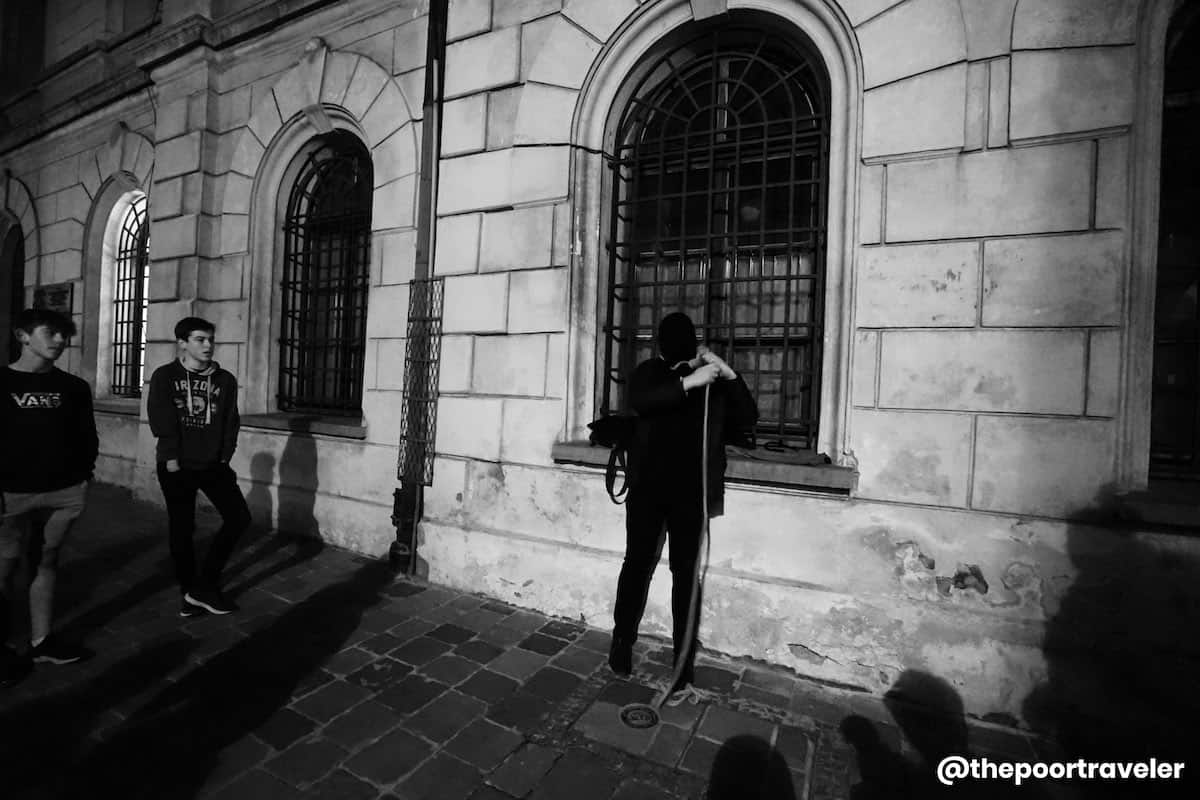
If you are into urban legends and mysteries, you can go join a different kind of sightseeing tour when the night rolls in. Ghost and Legends Tour is an alternative option that usually tackles the taboo topics and stories and includes secret and hidden places that are rumored to hold grim stories of tragedy and paranormal activities.
There are FREE walking tours that have this theme. Note that these tours are tip-based, so it depends on your experience how much you will give to the guide.
Nowa Huta District
For those who are curious about Polish life under communism, a trip to Nowa Huta District will give you a glimpse. Taking up a huge area in Krakow’s eastern portion, the district was meant to be an entirely separate industrial city and was pegged as an ideal socialist city when it was conceptualized in the 1940s.
However, in 1951, it was integrated into Krakow as a new district. Its abundance in parks and gardens make it the greenest zone in Krakow. The streets and the buildings are reminiscent of London and Paris.
Some of the notable landmarks in the district are Wanda Mound, Arka Pana Church, Church of Saint Bartholomew, PRL Museum, Nowa Huta Reservoir, Nowa Huta Underground, and Mogiła Abbey.
Getting There: Nowa Huta District is connected to the city’s tram system. The nearest station depends on where you want to explore in Nowa Huta. The center of the district is Plac Centralny, which is served by tram.
Polish Folk Show & Traditional Dinner
If you want to level up your quest for traditional Polish food, you can do your food trip while watching a Polish folk show in a cottage-style restaurant with the view of Kryspinow Lake.
The traditional performance involves lively singing and dancing, accompanied by musical instruments. You can book this activity online ahead of time. The package includes roundtrip transfers, folk dance show experience, and an all-you-can-eat-and-drink buffet. Vegetarian options are also available. This tour will take about three hours.
✅ CHECK RATES or RESERVE HERE!
Krakow Food Trip
Trying local food is one of the ways to immerse yourself in a place’s culture. Traditional dishes reveal a lot of a locale’s history and collective experience. Depending on your budget, you can get a taste of Polish cuisine from restaurants or stalls.
Here are some of the traditional Polish dishes that you can try when in Krakow:

- Bigos, a savory dish of cabbage and leftover meat. The cabbage can be sometimes a combination of pickled and fresh ones. Other ingredients are garlic, onion, mushroom, bay leaves, peppercorns, and caraway.
- Kiełbasa, Polish sausage that can be made from various types of meat. Two of the most famous are the Krakowska and Kabanosy. Krakowska is the specialty of Krakow, known for its distinct garlic and pepper seasonings. Kabansoy is a thin sausage seasoned with caraway.
- Pierogi, Polish version of dumplings, usually stuffed with potato, cheese, and meat. But it can be stuffed with various ingredients like vegetables, fruits, or even chocolate.
- Zapiekanka, Poland’s answer to pizza, but it uses half a baguette as crust, topped with cheese and mushrooms. Some vendors get more creative with their toppings, usually adding salami, pickles, and many others.
- Obwarzanek, Polish bagel that is usually sprinkled with sesame, salt, or poppy. This is one of the staples in Krakow.
- Żurek, a thick sour soup made of rye and prepared with potato, sausage, and hard-boiled eggs. Mushrooms and bacon are sometimes added into the soup.
- Kotlet Schabowy, Ta crispy breaded fried pork chop paired with mashed potato and pickled cabbage. You can easily find it anywhere in Krakow.
- Krówka, the traditional soft cream fudge packaged in small yellow wrappers. This dates back to the 1930s. It is made of milk, sugar, vanilla, and butter.
Kazimierz
Kazimierz is part of the first administrative district of Krakow and is also one of the three districts that make up the city’s historic center. The district flourished from the 14th until the 19th century when it functioned as an independent city near the fortified royal complex in Wawel and the Old Town center. It used to be the Jewish merchants’ hub until the 1940s, when the Nazis relocated the Jewish population to Podgorze on the other side of Vistula River, forming the Jewish Quarter.
Today, some of the structures, especially those on the northeast portion of Kazimierz, speak of its past as a thriving Jewish Quarter. There are about 10 synagogues scattered within the district and an Old Jewish Cemetery.
Other than Jew-related structures, the streets are lined with eccentric establishments, vintage and antique shops, hip restaurants and bars, and creative venues and art galleries.
Polish Aviation Museum
Located about six kilometers northeast of the Old Town district, the Polish Aviation Museum took over the defunct Kraków-Rakowice-Czyżyny Airport. It was opened in 1964 following the closure of the airfield in 1963.
It is considered one of the best aviation museums in the world, housing over 200 aircraft and about a hundred engines. Among these collections are rare and unique models. The museum also has an extensive library dedicated to aviation.
Nearest Tram Station: Muzeum Lotnictwa Station or AWF Station (Tram 4, 5, 9, 10, 44, 52)
Opening Hours: 9:00 AM – 5:00 PM (Tuesday – Sunday), CLOSED (Mondays)
Entrance Fee: zł15/€3.5 (Regular), zł7/€1.6 (Reduced), FREE (7 y/o and below). Admission is free every Tuesday for the permanent exhibitions.
Wawel Castle & Cathedral
Wawel Hill cradles an important cultural complex dotted with many historically and culturally significant structures, including the Wawel Royal Castle and the Wawel Cathedral.
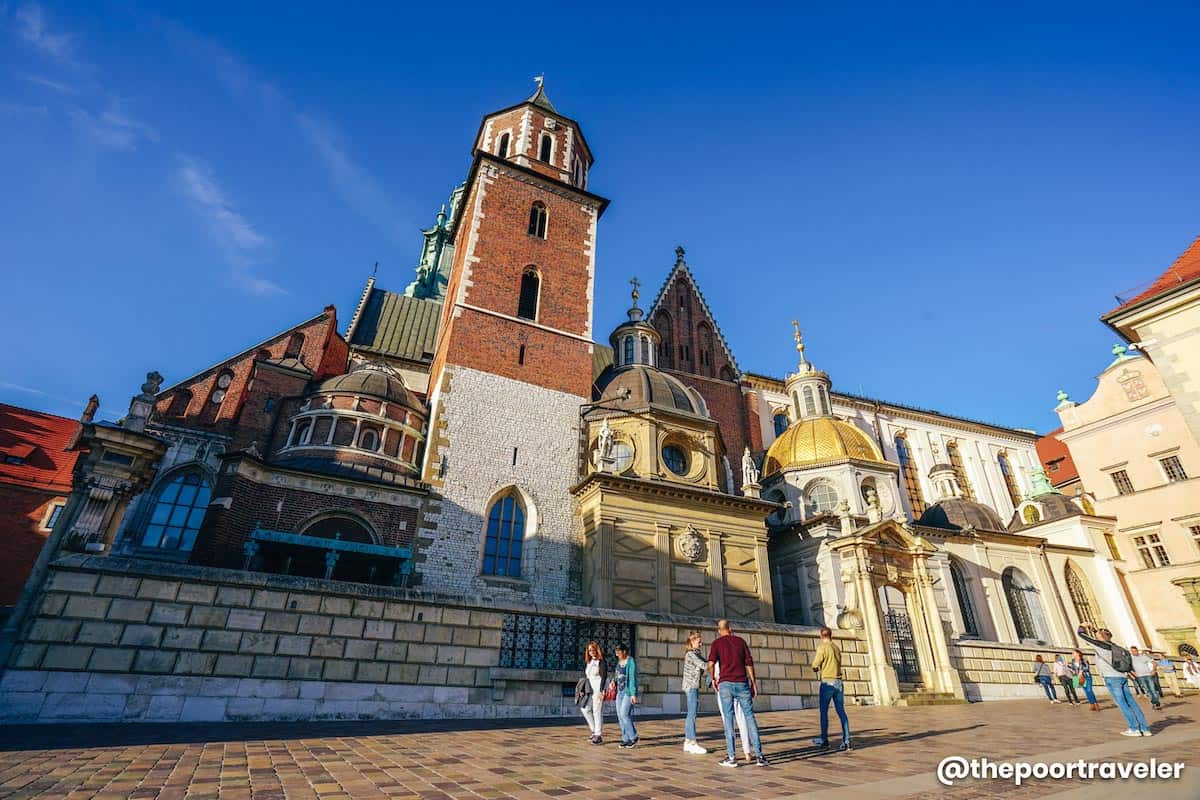
The 14th-century Wawel Castle served as the royal residence of the Polish monarchs for centuries, adopting different architectural styles — Medieval, Renaissance, and Baroque. It is one of the first structures to be included in the original UNESCO World Heritage Site list. Today, it functions as one of Poland’s outstanding art museums.
The Wawel Cathedral, a Gothic Catholic church that is almost a thousand years old, witnessed a lot of Polish royal coronation ceremony and housed a number of royal chapels and crypts. Other important national figures were also buried here. It was declared the country’s national sanctuary. Some of the cathedral’s points of interest are the iconic three towers (Sigismund’s Tower, Silver Bell Tower, and Clock Tower), the Treasury, Holy Trinity Chapel, Tadeusz Kościuszko Monument, the sarcophagus of Jadwiga of Poland (first female Polish monarch), and the tombs and crypts.
Nearest Tram Station: Wawel Station (Tram 1, 6, 8, 13, 18)
Nearest Bus Stop: Wawel Stop (Bus 610, 662)
Opening Hours: For Wawel Castle, the opening hours vary, but the usual schedule is from 9:00 AM to 5:00 PM. For Wawel Cathedral, 9:00 AM – 4:30 PM. Note that the cathedral’s museum is closed on Sundays.
Entrance Fee: For Wawel Castle, the entrance fee varies per exhibition/site. You may check the rates here: Wawel Castle Rates. For Wawel Cathedral, it’s zł14/€3 for regular tickets and zł8/€2 for reduced tickets. Note that they do not accept any currencies (including Euro) other than the zloty.
Admission to Wawel Hill and the courtyard is FREE.
Rynek Underground
Launched in 2010, this subterranean museum is one of the most popular in Poland. Rynek Underground can easily be overlooked if you don’t do your research prior to your visit to Krakow because the museum lies four feet beneath the Main Market Square.
It spans over 6,000 square meters and features medieval artifacts, an archaeological site, multimedia exhibitions, and recreations of the past period, particularly the Middle Ages. Its permanent exhibition is titled Following the Traces of European Identity of Kraków. It presents the history of Krakow up to the Medieval Period by applying modern technology like holograms, projections, and touchscreens in recreating important events.
The entrance to the underground museum is at the northeast side of the Cloth Hall.
Nearest Tram Station: Poczta Główna Station (Tram 3, 10, 24, 52); Plac Wszystkich Świętych Station (Tram 1, 6, 8, 13, 18); Teatr Bagatela Station (Tram 2, 4, 14, 18, 20, 24)
Opening Hours: 10:00 AM – 7:00 PM (Monday, Wednesday – Thursday); 10:00 AM – 2:00 PM (Tuesday); 10:00 AM – 8:00 PM (Friday – Sunday); CLOSED (every 2nd Monday of the month)
Entrance Fee: zł24/€5 (Regular), zł20/€4.5 (Reduced). Note that it is recommended to reserve your ticket in advance online. FREE ADMISSION on Tuesdays!
Rynek Główny (Main Market Square)
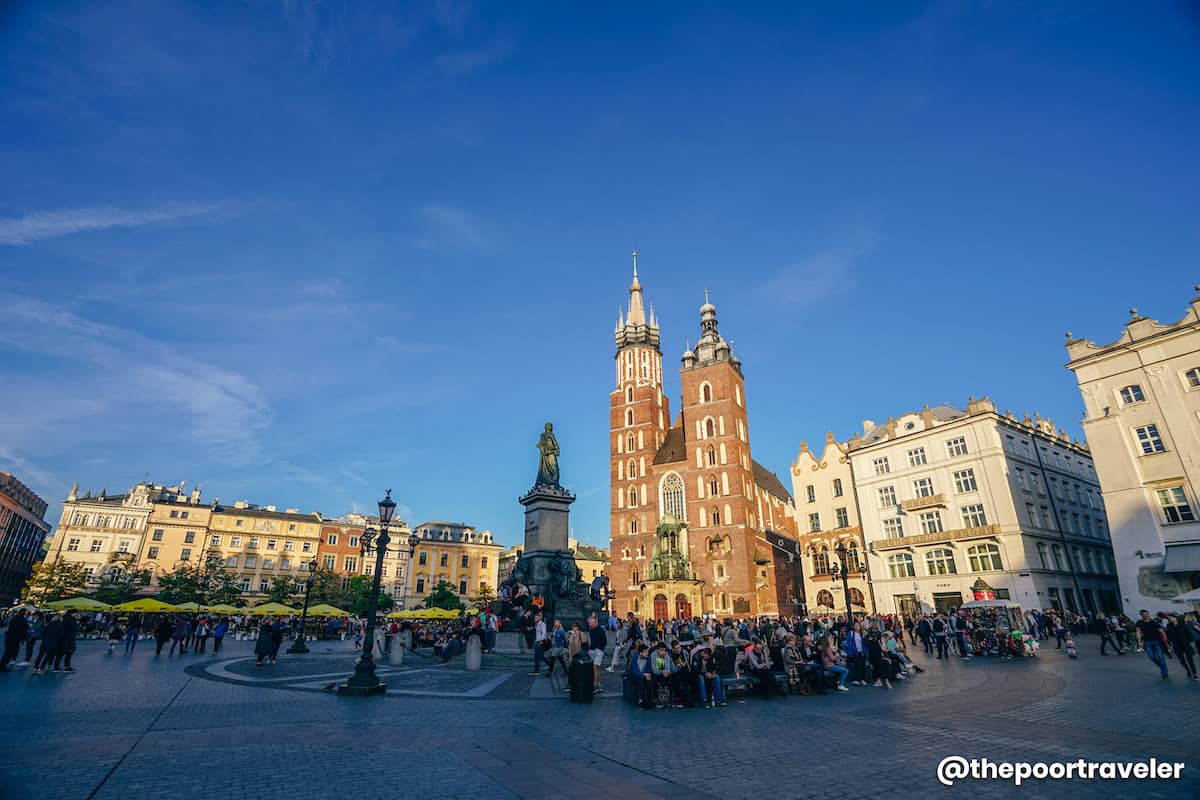
Located at the heart of the Old Town district, Rynek Główny is hard to miss. Why? With an area of almost four hectares, it’s said to be the largest medieval square in Europe. Its history can be traced back to the 13th century when it was a bustling commercial square.
Fringed with ancient establishments and structures like churches and townhouses, exploring the vast square is like standing in a feast of culturally delightful historical treats. The Renaissance-style Sukiennice (Cloth Hall) is the iconic centerpiece of the square. It is joined by two other equally symbolic landmarks — the freestanding Gothic Town Hall Tower and 19th-century Adam Mickiewicz Monument.
Other historical structures in the area are the 11th-century Church of St. Adalbert and St. Mary’s Basilica, which we will discuss more in the next section.
Nearest Tram Station: Poczta Główna Station (Tram 3, 10, 24, 52); Plac Wszystkich Świętych Station (Tram 1, 6, 8, 13, 18); Teatr Bagatela Station (Tram 2, 4, 14, 18, 20, 24)
Opening Hours: 24/7
Entrance Fee: FREE
Kościuszko Mound
Located in Zwierzyniec District, just a few kilometers west of Krakow city center, Kościuszko Mound is just one of the two modern mounds that were built to honor important historical figures. It commemorates the Polish national leader Tadeusz Kościuszko. The other modern memorial mound is Piłsudski’s Mound, located further west.
Completed in 1823, its inspirations are the two prehistoric mounds in Krakow — Krak and Wanda. Kościuszko Mound features a spiraling path from the base to the top, a granite boulder from the Tatra mountains crowning the top, and urns buried inside the mound using the soil from the locations of the battles where Kościuszko fought. Getting to the top will reward you with the view of the Vistula River and the surrounding landscape.
Nearest Tram Station: Salwator Station (Tram 1, 2). Note that this entails over 1km uphill hike from the station to the mound.
Nearest Bus Stop: Kopiec Kościuszki Stop (Bus 100, 101)
Opening Hours: 9:30 AM – 6:30 PM (Daily)
Entrance Fee: zł18/€4 (Regular), zł14/€3 (Reduced). This covers admission fee, temporary exhibitions, and permanent exhibitions. You can pay in cash or by credit card.
Krakus Mound
Located on Lasota Hill in Podgórze district, the Krakus Mound is one of the two prehistoric mounds, the other one is Wanda Mound.
The primeval burial mound is believed to be the final resting place of King Krakus, Krakow’s mythical founder. It is also believed to be the oldest manmade structure in Krakow.
There were four smaller mounds surrounding it until they were torn down to build the old royal city’s defensive walls in the 19th century. The peak provides a panoramic view of the city.
Nearest Tram Station: Podgórze SKA Station (Tram 3, 6, 11, 13, 24)
Nearest Bus Stop: Podgórze SKA Stop (Bus 143, 274, 301, 669)
Note: If you are coming from Park Bednarskiego, you can reach Krakus Mound on foot via Dembowskiego street leading to the pedestrian bridge, and finally, the base of the mound.
Opening Hours: 24/7
Entrance Fee: FREE
St. Mary’s Basilica
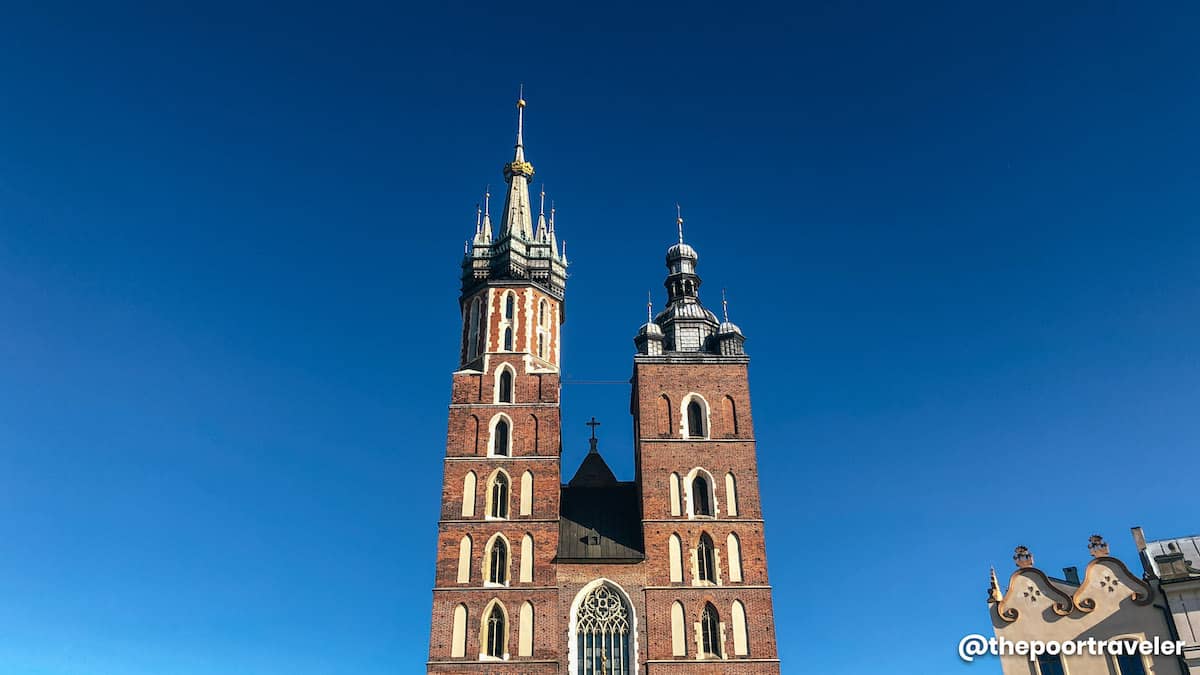
St. Mary’s Basilica is a 14th-century basilica, declared a UNESCO World Heritage Site in 1978. Towering at 80 meters, this Gothic church is one of the dominant structures surrounding Rynek Główny (Main Market Square).
Its two towers and brick building material present an imposing aura, commanding attention. The main features are the late Gothic wooden altarpiece by renowned German sculptor Veit Stoss and its hourly trumpet call.
Nearest Tram Station: Poczta Główna Station (Tram 3, 10, 24, 52) or Plac Wszystkich Świętych Station (Tram 1, 6, 8, 13, 18)
Opening Hours: Basilica 11:30 AM – 6:00 PM (Daily); Bugle Tower 10:00 AM – 5:30 PM (Friday & Saturday), 1:00 PM – 5:30 PM (Sunday), CLOSED (Monday – Thursday); For the Bell Tower tour, you need to book in advance by sending an email to turystyka@mariacki.com.
Entrance Fee: Basilica Tour zł10/€2.5 (Regular), zł8/€2 (Senior), zł5/€1 (Student/Child); Bugle Tower zł15/€3 (Regular), zł10/€2.5 (7-18 y/o); Bell Tower zł15/€3 (Adults only)
Saints Peter and Paul Church
Situated on the southeastern portion of the Old Town district along Grodzka (Castle Street), the Saints Peter and Paul Church is one of the biggest ancient churches in Krakow.
Completed in the early 17th century, the church follows the Baroque style and is said to be the first-ever Baroque structure to be built in Krakow.
It is most famous for its Focault Pendulum, which is the longest in Poland at over 46 meters. Named after the French scientist Leon Focault, the pendulum demonstrates the Earth’s rotation/movement. You can witness this every Thursday from 11AM to 12PM.
The church also features one of the country’s National Pantheons, hosting the tombs of famous personalities, particularly in the fields of arts, science, and culture.
Nearest Tram Station: Plac Wszystkich Świętych Station (Tram 1, 6, 8, 13, 18)
Opening Hours: 9:00 AM – 5:00 PM (Monday – Saturday), 1:30 PM – 6:00 PM (Sundays)
Entrance Fee: FREE
St. Joseph’s Church
St. Joseph’s Church dramatically punctuates the apex of the triangular Podgórski Square. Sporting a Neo-Gothic architectural style, the church was built in the early 20th century. The brick facade is imposing with its impeccable masonry and 80-meter clock tower.
Behind the church is the lush Park Bednarskiego with its gardens, walking paths, and a playground.
Nearest Tram Station: Korona Station (Tram 6, 11, 13, 17, 19)
Opening Hours: Visitors are allowed before and after mass schedules. Please check the official website before your visit if you want to go inside the church.
Entrance Fee: FREE
Barbican (Barbakan Krakowski)
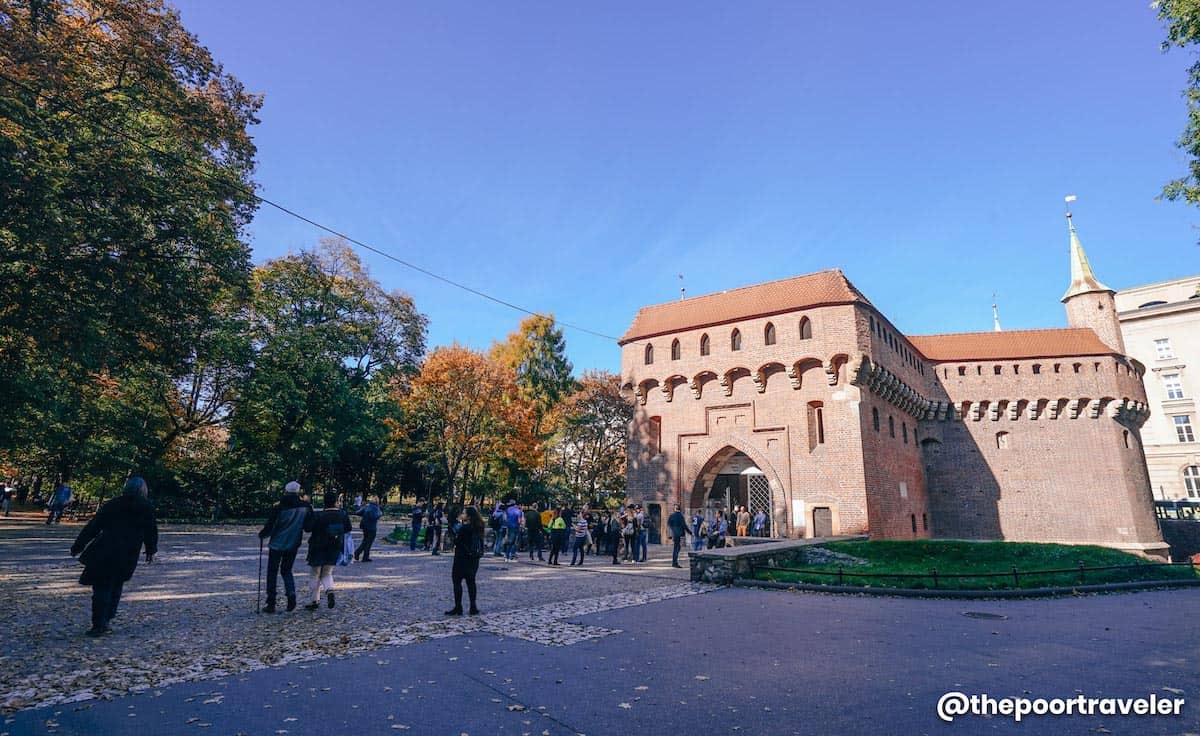
Barbakan Krakowski (or simply the Barbican) is one of the three remaining fortified outposts in Europe. It was built in the late 15th-century along the coronation route and used to be part of the walls surrounding the royal city, which is the Old Town center.
The Gothic cylindrical brick structure is the largest in Poland and features a moat, an inner courtyard, over a hundred defensive slots, and seven turrets. Considered a military engineering gem, it served as a defensive structure and a checkpoint to the royal city. It still stands valiantly at the entrance of the Old Town district up to this day.
Nearest Tram Station: Stary Kleparz Station or Teatr Słowackiego Station (Tram 2, 4, 14, 20, 24, 44)
Opening Hours: 11:00 AM – 6:00 PM (Monday – Sunday), CLOSED (2nd Monday of each month and holidays)
Entrance Fee: zł12/€3 (Regular), zł8/€2 (Reduced). Note that this includes City Defence Walls (Barbican & Florian’s Gate) and Celestat.
Museum of the Jagiellonian University – Collegium Maius
Located in the Old Town district’s western side, the Museum of the Jagiellonian University showcases well-preserved and restored centuries-old lecture halls, professors’ quarters, communal halls, paintings, antique scientific instruments, and a treasury that houses important artifacts, including the Jagiellonian globe.
The museum is hosted in the university’s oldest building, Collegium Maius, whose roots go all the way to the 14th century. It features a 15th-century arcaded courtyard with a well at the center, which was added in the 16th century, and a musical clock.
One of the most prominent historical and academic figures who studied in Collegium Maius is Nicolaus Copernicus, who proposed, controversially at the time, that the earth revolves around the sun and not the other way around. This heliocentric model is credited as the beginning of the Scientific Revolution in 1543.
Nearest Tram Station: Teatr Bagatela Station (Tram 2, 8, 13, 18, 20) or Uniwersytet Jagielloński Station (Tram 6, 20)
Opening Hours: 10:00 AM – 3:00 PM (Main Exhibition, Monday – Friday); 9:00 AM – 6:00 PM (Courtyard, Monday – Saturday)
Entrance Fee: zł12/€2.7 (Regular), zł6/€1.5 (Reduced)
St. Florian’s Gate and Florianska Street
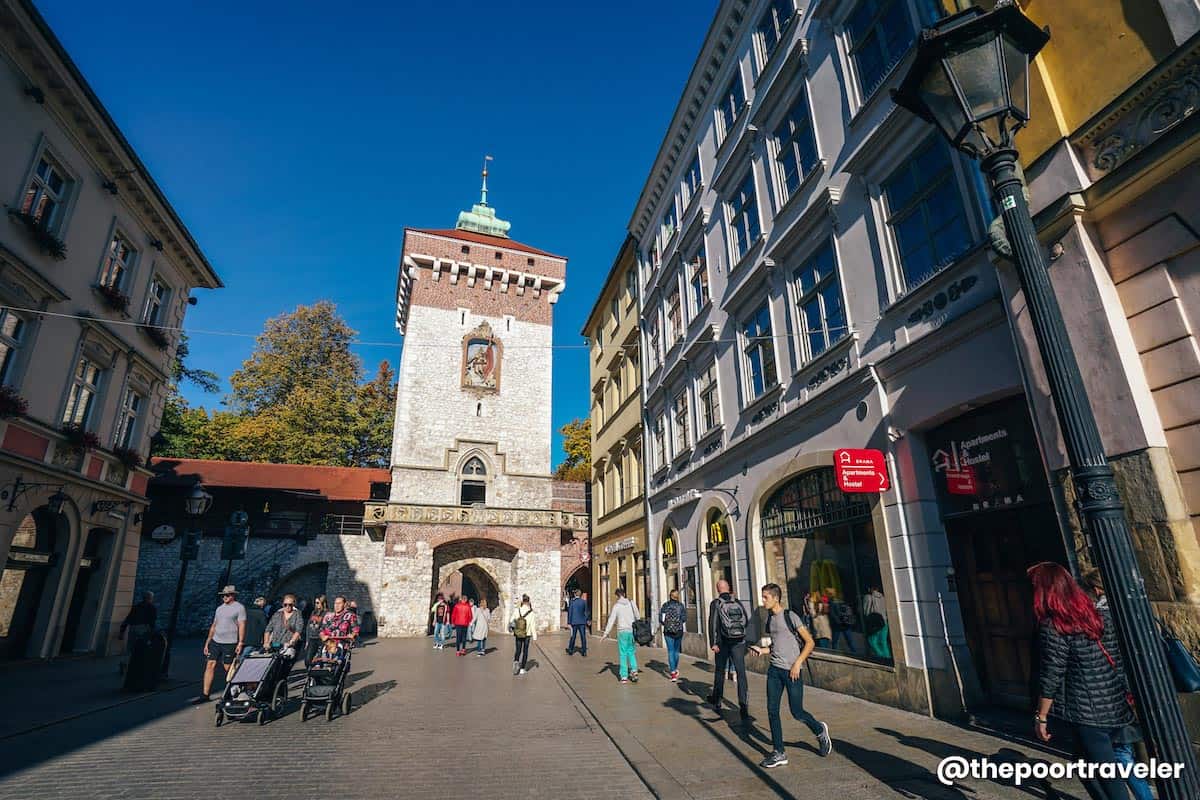
Just like the Barbican outpost, St. Florian’s Gate (or simply Florian Gate) was constructed in the 14th century as part of the complex fortification system built around the Old Town center (royal city) to protect it from the Moors’ attack.
This rectangular stone tower was one of the eight gates to the royal city and was originally linked to the Barbican by a bridge, serving as the main entrance to the medieval town center. It also served as a jump-off point for the coronation procession which transpires along the Royal Road.
The Royal Road, also called the coronation route, covers Florianska (Florian Street), Main Market Square, Grodzska (Castle Street), and all the way to Wawel Castle. Florianska Street is one of the Old Town’s main streets and a key tourist spot. Flanked by commercial establishments like boutiques, shops, restaurants, and cafés, it is flocked by tourists, making it one of the busiest streets in Krakow.
Nearest Tram Station: Stary Kleparz Station or Teatr Słowackiego Station (Tram 2, 4, 14, 20, 24, 44)
Opening Hours: For Florian’s Gate, it’s 8:00 AM – 6:00 PM (Monday – Saturday) and CLOSED on Sundays. For Florianska, it’s open 24/7.
Entrance Fee: For Forian’s Gate, zł12/€3 (Regular), zł8/€2 (Reduced). Note that this includes City Defence Walls (Barbican & Florian’s Gate) and Celestat. For Florianska, FREE.
Dragon’s Den (Smocza Jama)
Smocza Jama, literally means Dragon’s Den in Polish, is a limestone cave on the western slope of the Wawel Hill within the Old Town district. The cave stretches almost 300 meters and can be accessed via two entrances. It has an underground pool and a side passage that ends beneath St. Stanislaus and St. Wenceslaus’s Cathedral.
In the 18th century, the main entrance was closed to support the construction of the Wawel fortress. Two other openings were blocked several years later. It was relaunched to the public in 1842.
The cave is often associated with the legendary Wawel Dragon. A statue of a fire-breathing dragon was installed at the entrance of the cave in 1972. The statue still greets visitors up to this day.
Nearest Tram Station: Wawel Station (Tram 1, 6, 8, 13, 18)
Opening Hours: 10:00 AM – 5:00 PM (Daily)
Entrance Fee: zł7/€1.6. Note that they don’t accept payment in Euro and there’s a limit of 50 persons at a time.
Planty Park
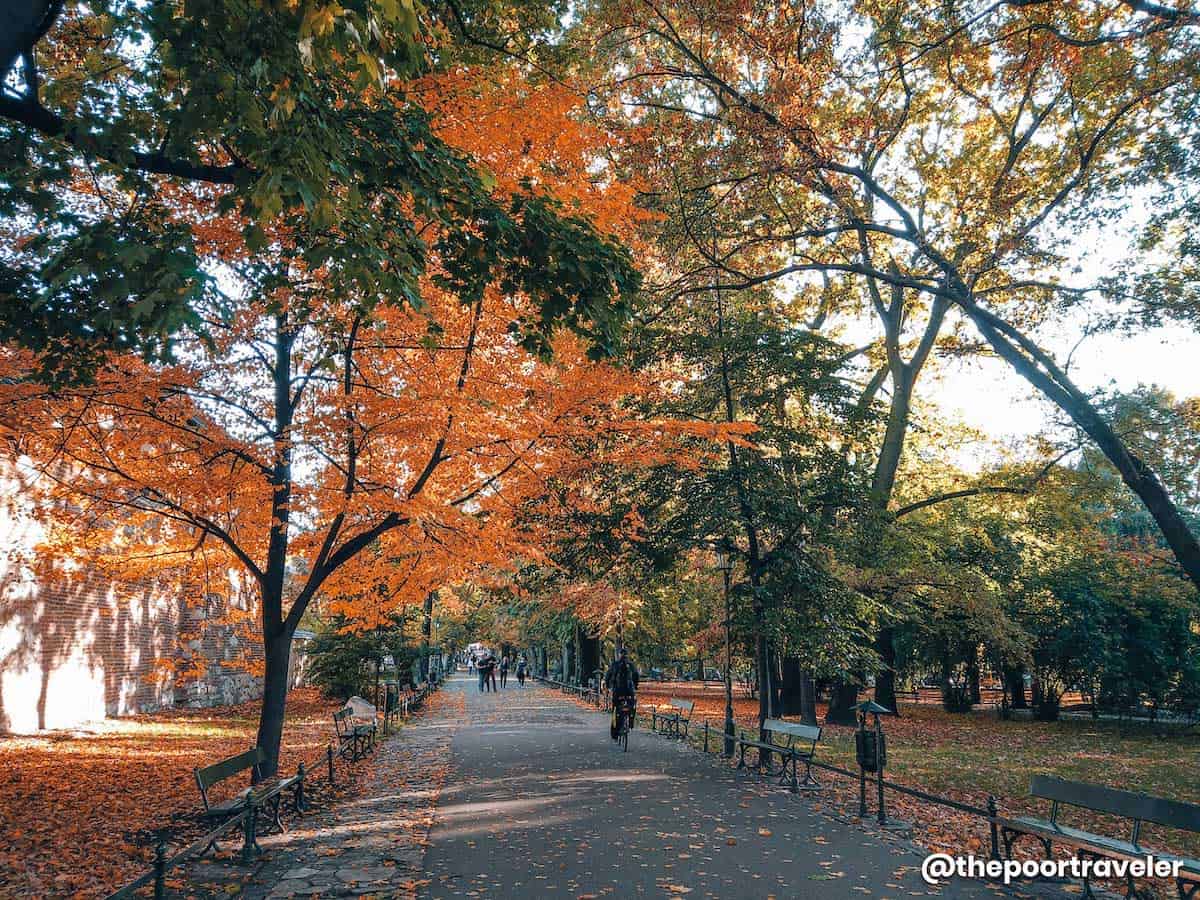
Planty Park is a reminder of the ancient defensive walls that once surrounded and protected the historic Old Town which housed the royal city. The green belt that exists today replaced these medieval walls in the early 19th century and separates the historic Old Town from the rest of the city.
The whole four kilometers of greenery is made up of thirty smaller gardens with picturesque walkways and peppered with several statues and fountains. It’s extra stunning in autumn!
Nearest Tram Station: There are quite a number of tram station dotting the whole loop of Planty Park. The nearest tram station depends on where you want to explore first.
Opening Hours: 24/7
Entrance Fee: FREE
Wieliczka Salt Mine
The Wieliczka Salt Mine is listed as one of the country’s Historic Monuments and is a UNESCO World Heritage Site (together with Bochnia Salt Mine).
Operating from as early as the 13th century until 2007, it was hailed as one of the world’s oldest operating salt mines. Today, it is one of the most famous tourist attractions in Poland.
The salt mine stretches for almost 290 kilometers at a depth reaching about 330 meters. It features an underground lake, four chapels and statues that the salt miners carved themselves, and other chambers. There are newer statues carved out of the rock salt by contemporary artists.
There’s also a collection of items describing the ancient salt-mining process and technology. Aside from the maze-like passageways, the salt mine also has an elevator.
Nearest Train Station: Wieliczka Rynek Kopalnia Station. Take the suburban train from Krakow Glony Station to Wieliczka Rynek Kopalnia Station. From there, you can reach the salt mine on foot in 10-15 minutes.
Nearest Bus Stop: Wieliczka Kopalnia Soli Stop (Bus 224, 274, 304)
Opening Hours: 8:00 AM – 5:00 PM (Daily)
Entrance Fee: zł93/€21 (Regular), zł84/€19 (Seniors & Students), zł73/€16 (Children), FREE (4 y/o and below). The fee is inclusive of an English-speaking guide. There is a separate fee for the Graduation Tower: zł9/€2 (Regular) and zł6/€1.3 (Reduced).
Tyniec
Tyniec was integrated into the city in 1973 as part of the Debniki District. Historically, the village thrives by shuttling products and people through the Vistula.
The landscape is characterized by limestone hills, canyons, and lush forests, forming a natural reserve. The village also has its own water source — Zrodlo Swietojanskie.
The most prominent landmark is the 11th-century Benedictine abbey founded by King Casimir the Restorer. Sitting atop the limestone ridge, its location on the edge of the hill blessed it with the scenic view of the Vistula River and beyond. The abbey has a restaurant and a café.
Getting There: Take the tram to Rondo Grunwaldzkie Station, past the Grunwald Bridge from Kazimierz. From there, head to the bus stop and board Bus 112 to Tyniec Bus Stop. If heading to the abbey, the distance between the bus stop and the abbey entrance is over 600 meters. The bus travel duration is about 30 minutes. If walking is your thing, you can just walk from Kazimierz to the Rondo Grunwaldzkie bus stop. Some tourists go there by bicycle; others go via river cruise, which takes about an hour and a half.
Top Budget Hotels & Apartments in Krakow
Below are some of the top-rated apartments and budget hotels in Krakow’s key areas, as reviewed by Agoda customers.

- Bentis Luxury Apartments. Check Rates & Photos! ✅
- Apartament Golden Place 2. Check Rates & Photos! ✅
- 1891 Aparthotel. Check Rates & Photos! ✅
- Trip Apartments. Check Rates & Photos! ✅
- Ruumz Bed & Rest. Check Rates & Photos! ✅
- Academia Apartments. Check Rates & Photos! ✅
- Barbakan Residence Old Town. Check Rates & Photos! ✅
- Old Time Apartments. Check Rates & Photos! ✅
Search for more Krakow Hotels!
2020 • 12 • 25
